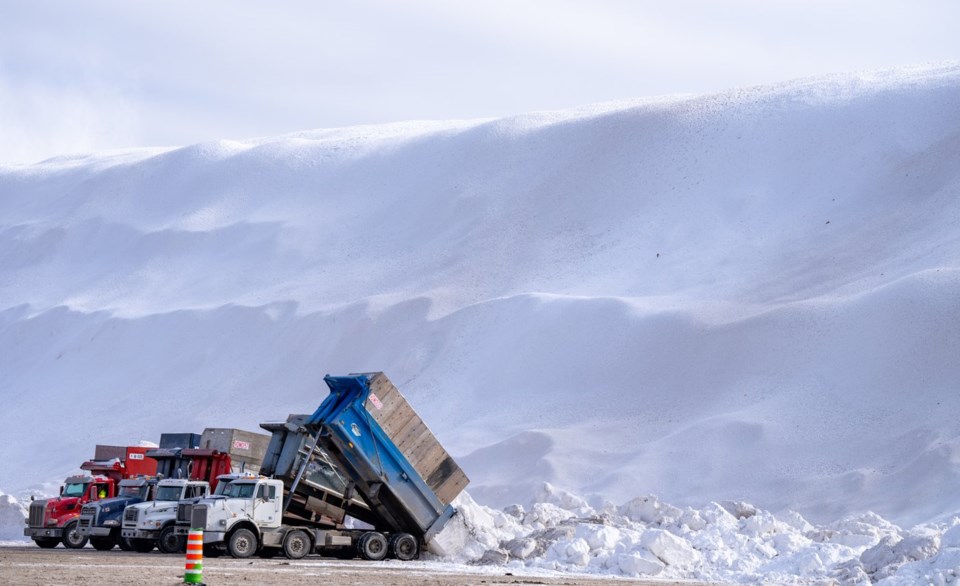MONTREAL — In Montreal's southwest, by the Lachine Canal, trucks come and go like clockwork, dumping loads of snow as blowers the size of tanks send it cascading in the air onto a 10-storey-high bank. Known as the Angrignon snow depot, it is one of 10 sites across Montreal storing the record-breaking snowfall that hit the city in recent days.
Each winter, Montreal deploys an army of people to clear the roads and sidewalks, many of whom are working overtime after the city received more than one-third of its annual snowfall over four days earlier this month. On Friday, city officials estimated that the cavalry will be at work for at least another 10 days to clear the more than 70 centimetres that fell between Feb. 13-16.
“We’ve removed 32 per cent of the snow … There’s still a lot of work to do,” Montreal Mayor Valérie Plante told reporters at the Angrignon depot, after dismounting a snowblower. Each of the 10 storage sites can collect approximately 800 Olympic swimming pools' worth of snow, Plante said.
Brian Levasseur Gallagher, spokesperson for Beluga Construction, which manages the Angrignon site with the city, said trucks are making 3,000 trips to the depot each day to dump snow.
On average, 12 million cubic metres of snow are removed from the streets of Montreal each winter, enough to fill the Olympic Stadium 10 times, City of Montreal spokesperson Philippe Sabourin said in an interview Thursday. Environment Canada estimates that Montreal receives a yearly average of 217 cm of snow, and this winter so far 172 cm have fallen – 42 per cent of it over four days in February.
Winter storms are a significant expense for taxpayers. About 20 cm of snow accumulates during the average snowstorm, which takes four days to remove, with each centimetre costing the city about $1 million, Sabourin said. Montreal’s snow budget is just over $200 million.
Aside from depositing snow at sites such as Angrignon, the city also dumps about 20 per cent of its cleared snowfall into 13 sewers, which carry it to a wastewater treatment plant before it is released it into the St. Lawrence River.
The city has deployed some 3,000 workers and 2,500 vehicles, Sabourin said, with half of those workers employed through the private sector. About 450 are involved in towing operations alone.
Each year, Sabourin said, the city purchases about 200,000 tons of snow salt and crushed limestone, which is stored in 30 municipal garages. At each facility, a “cook” mixes the stone and salt: the recipe is 90 per cent salt and 10 per cent rock for roads, and a 50-50 mixture for sidewalks, he said.
And there is a lot of road to clear. The city has 11,000 kilometres of streets, sidewalks and bike paths, equalling the distance between Montreal and London, England – back and forth, he said.
The municipal agency that issued parking violations – Agence de mobilité durable de Montréal – says about 6,000 to 9,000 vehicles are towed each time a snow-removal operation takes place. Over last year's winter, which was milder compared to this year's, the agency ticketed and towed nearly 17,400 vehicles over two snow-loading operations. About 2,770 vehicles were ticketed but not towed.
Those figures are way up this winter. As of Thursday, the agency ticketed and towed nearly 26,700 vehicles over four snow-removal operations; 6,415 vehicles were ticketed but not towed. A driver whose car is towed faces a ticket of $194.
Matthew Stanwyck, who owns and operates West Island Tow Trucks, has been towing cars for nearly four decades. He specializes in towing luxury vehicles, and come winter his phone rings non-stop from people whose vehicles are snowed-in. This winter is the busiest in recent years.
A one-man show, Stanwyck said he has pulled up to 130 vehicles out of the snow since Feb. 13, and towed about 30 vehicles. “I don’t go home until the phone stops ringing,” he said in an interview Thursday.
Paulo Saade, who owns and operates Remorquage Elite, says he pulled up to 500 vehicles out of the snow and towed 150 vehicles over the past seven days. “The whole city is going crazy. Everybody’s stuck. Everybody's having issues. I think we received about 300 to 500 calls a day,” he said in an interview Thursday.
Meanwhile, the snow that is deposited across the 10 storage sites can take years to melt. At the Francon quarry in Montreal’s north end, where the city dumps about one-third of snow from clearing operations, there is still snowpack from 10 years ago.
Mounds of snow turn into a type of glacier, Sabourin said, while the crushed limestone inside the snow rises to the top of each dumped layer, creating an insulating barrier that slows the melting process – even in the summer.
“It’s crazy,” he said. “Think about it.”
This report by The Canadian Press was first published Feb. 22, 2025.
Joe Bongiorno, The Canadian Press
